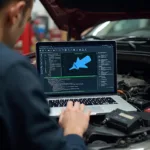The OBD2 port, short for On-Board Diagnostics, is your vehicle’s communication gateway. Knowing how to test obd2 port functionality is crucial for diagnosing car troubles and ensuring your vehicle runs smoothly. This guide provides a comprehensive walkthrough of various OBD2 port testing methods, from simple visual checks to more advanced techniques.
As a leading expert in OBD2 scanners, I understand the importance of a properly functioning OBD2 port. It’s the key to unlocking your car’s secrets and understanding its health. Testing your OBD2 port can save you time and money in the long run, preventing unnecessary trips to the mechanic. Learn how to test your OBD2 port today and empower yourself with essential car maintenance knowledge.
Understanding the OBD2 Port
Before diving into testing procedures, it’s essential to understand the OBD2 port’s function and location. The OBD2 port, mandated in vehicles since 1996, provides access to a vehicle’s diagnostic trouble codes (DTCs). These codes offer invaluable insights into the potential issues affecting your car’s performance.
The OBD2 port is typically located under the driver’s side dashboard, near the steering wheel or center console. However, its exact location can vary depending on the car’s make and model. Consult your vehicle’s owner’s manual for the precise location if you’re having trouble finding it.
For more detailed information on testing a specific port type, you can refer to our guide on how to test jumper obd2 port.
Visual Inspection: The First Step in OBD2 Port Testing
The initial step in testing your OBD2 port involves a simple visual inspection. Check for any bent or broken pins, debris, or signs of physical damage. Even a slight bend can disrupt the connection between your scanner and the port. If you find any foreign objects lodged in the port, carefully remove them using tweezers or compressed air. A clean and undamaged port is crucial for accurate diagnostics.
Testing OBD2 Port with a Scanner: Unlocking Diagnostic Codes
The most effective way to test your OBD2 port is by using an OBD2 scanner. These handy devices plug directly into the port and communicate with your car’s computer. A successful connection indicates a functioning OBD2 port. For help with selecting the right software to read the port information, check out our guide on computer obd2 software.
When choosing a scanner, consider your needs and budget. Basic scanners display DTCs, while more advanced models offer live data streaming and other functionalities. You can learn more about testing OBD2 ports with different methods in our article on testing obd2 port.
Checking for Power: Using a Multimeter for OBD2 Port Testing
A multimeter can confirm power to the OBD2 port. This involves checking specific pins for the correct voltage. Consult your vehicle’s wiring diagram for the designated power pins. Typically, pin 16 should have 12V power. If the multimeter readings deviate from the expected values, it could indicate a wiring issue affecting the OBD2 port. This more advanced method requires some electrical knowledge. If you’re unsure, consult a qualified mechanic.
If you’re facing issues with your Mini Cooper’s OBD2 port, you might find our guide on 2008 mini cooper obd2 test port helpful.
Mock OBD2 Port: Simulating for Emissions Testing
In some instances, you might need to simulate an OBD2 port, especially for emissions testing. A mock OBD2 port allows you to test the functionality of your emissions testing equipment without connecting to a live vehicle. This can be beneficial for technicians and DIY enthusiasts. You can explore our dedicated guide on mock obd2 port for emissions testing for more information on this topic.
Conclusion: Empowering Yourself with OBD2 Port Testing Knowledge
Knowing how to test obd2 port is an essential skill for any car owner. By understanding the simple visual checks and utilizing tools like OBD2 scanners and multimeters, you can effectively diagnose potential issues and ensure the proper functioning of your vehicle’s diagnostic system. Remember, a properly functioning OBD2 port empowers you to maintain your vehicle’s health and address problems proactively.
FAQ
-
What is the OBD2 port used for? The OBD2 port allows access to your vehicle’s diagnostic trouble codes (DTCs), providing insights into potential issues.
-
Where is the OBD2 port located? Typically, it’s under the driver’s side dashboard near the steering wheel or center console.
-
What tools do I need to test the OBD2 port? A visual inspection can be done without tools. A scanner or multimeter provides more in-depth testing.
-
What if my OBD2 port is damaged? Consult a qualified mechanic for repair or replacement.
-
Can I test the OBD2 port without a scanner? Yes, a visual inspection and multimeter test can be performed without a scanner.
-
What does it mean if my scanner doesn’t connect to the OBD2 port? This could indicate a faulty port, wiring issues, or a problem with the scanner itself.
-
Why is testing the OBD2 port important? It’s crucial for diagnosing car troubles and ensuring your vehicle runs smoothly.
For further assistance, please contact us via WhatsApp: +1(641)206-8880, Email: [email protected], or visit our office at 789 Elm Street, San Francisco, CA 94102, USA. Our 24/7 customer support team is always ready to help.

